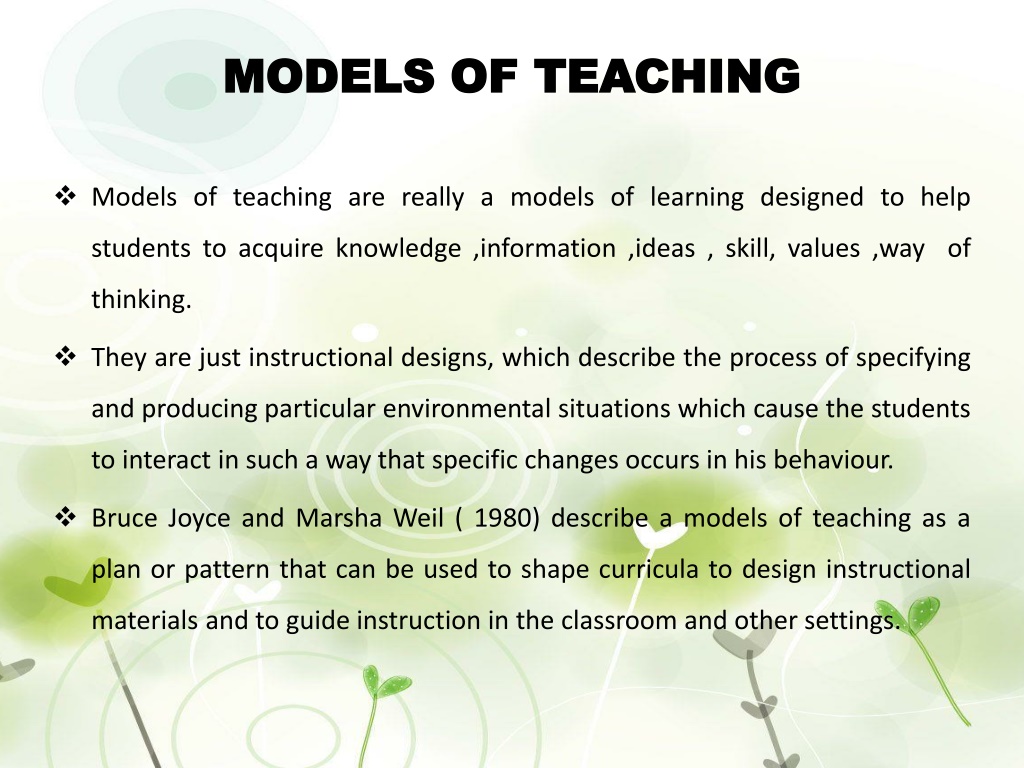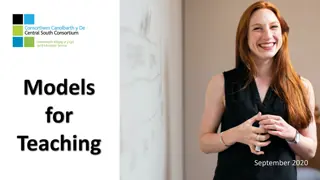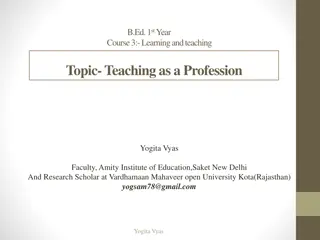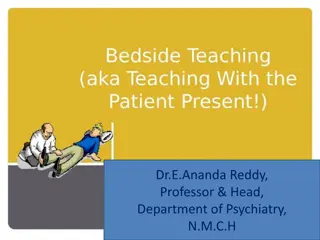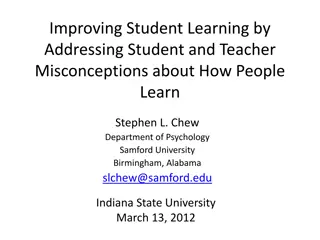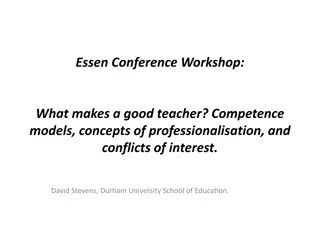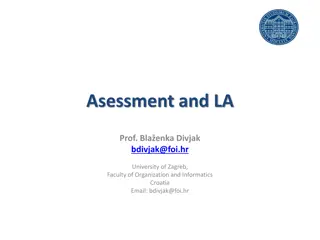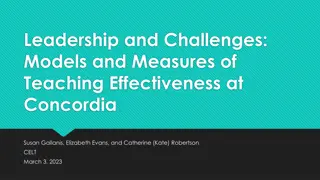Understanding Models of Teaching for Effective Learning
Models of teaching serve as instructional designs to facilitate students in acquiring knowledge, skills, and values by creating specific learning environments. Bruce Joyce and Marsha Weil classified teaching models into four families: Information Processing Models, Personal Models, Social Interaction Models, and Behavior Modification Models. Each family encompasses different models aimed at enhancing learning in various ways.
Download Presentation

Please find below an Image/Link to download the presentation.
The content on the website is provided AS IS for your information and personal use only. It may not be sold, licensed, or shared on other websites without obtaining consent from the author. Download presentation by click this link. If you encounter any issues during the download, it is possible that the publisher has removed the file from their server.
E N D
Presentation Transcript
MODELS OF TEACHING MODELS OF TEACHING Models of teaching are really a models of learning designed to help students to acquire knowledge ,information ,ideas , skill, values ,way of thinking. They are just instructional designs, which describe the process of specifying and producing particular environmental situations which cause the students to interact in such a way that specific changes occurs in his behaviour. Bruce Joyce and Marsha Weil ( 1980) describe a models of teaching as a plan or pattern that can be used to shape curricula to design instructional materials and to guide instruction in the classroom and other settings.
FAMILIES OF MODELS OF FAMILIES OF MODELS OF TEACHING TEACHING Bruce Joyce and Marsha Weil (1980) classified models into four families. They are: 1.Information Processing Models 2. Personal Model 3 .Social Interaction Models 4. Behaviour Modification Models.
INFORMATION PROCESSING MODEL These models focus on intellectual capacity. The primary goals are : a. Help individual to acquire knowledge through the analysis of data. b .Helps to develop general intellectual skills c. fostering the ability to think logically.
The Models which belong to this family are: 1. Concept Attainment Model This model designed primarily to develop inductive reasoning but also for concept development analysis 2.Advance Organiser Model This model is designed to increase efficiency or information processing capacities to absorb related body of knowledge. David Ausubel is the exponent of this model.
3. Inductive Thinking model This model designed primarily for development of inductive mental processes and academic reasoning . Hilda taba is the exponent this model. 4.Cognitive growth model This model designed to increase the general intellectual development especially logical reasoning. Jean piaget is the exponent of this model. 5.Inquiry Training model This model to teach students the art of independent inquiry in disciplined way 6. Memory model 7. Biological science inquiry model
SOCIAL INTERACTION FAMILY The models in this family emphasis the relationship of the individual to society. The primary goals are To train students work together. To inculcate personal and social values To develop skill for maintaining human relation
The model which belong to this family are: a.Group Investigation model b. Role playing Model c. Jurisprudential Inquiry Model d .Laboratory Training Model e .Social Stimulation Model f. Social Inquiry Model
BEHAVIOUR MODIFICATION MODEL The common thrust of these model is the emphasis on changing the observable behaviour of the learner. The specific goals are: To master techniques for stress reduction To develop the competency to adapt behaviour styles To foster leadership qualities
The models which belong to this family are 1.Anxiety Reduction model 2.Assertive Training Model 3.Managing Behaviour model 4.Programmed Instructional model 5.Relaxation model
PERSONAL MODEL Models which belongs to this family deal with the personal development of the individual . The primary goals are. to help students understand To increase the students sense of self worth. To help students refine their emotion to foster the students creativity The models which belong to this family are Non Directive Teaching Model Synectics model Awareness Training Model Classroom Meeting Model
ELEMENTS OF TEACHING MODEL The models developed by Bruce Joyce and Marsha Weil have a definite structure. Each Model is described within the structure. The six elements of this structure are: 1. Focus 2. Syntax 3. Social system 4. Principles of reaction 5. Support system 6. Instructional and nurturant effect
1.Focus It is main the aspect of a teaching model. Name and objective of teaching constitute the focus. It refers to the goals or objective of teaching. 2.Syntax It deals with phases of the model. It involves a description or structure of activities. It refers the presentation aspect of teaching. 3. Social system It describes the between the teacher and the pupils. role and relationship
4. Principles of reaction Teacher reacts to the response of the students. 5. Support system It refers to the additional requirements other than facilities usually available in the classroom. 6.Effects of the Model Instructional effect : These are the direct effects of the model which result from the content and the skill on which the activities are based. Nurturant effect : They are indirect effect of the model .These are the implicit in the learning environment.
CONCEPT ATTAINMENT MODEL Concept attainment model is designed to help students to learn concepts and help them to become more effective in learning concepts It has been based upon the studies made by Jerome S Bruner and his associates Jacqualine Good now and George Austin. The
What is a Concept ? Concept is mental representation or a mental picture of some objects or experience. It represents a category of objects which share common properties.
Elements of a concept. According to Bruner a concept includes five elements. They are: a. Name b. Exemplars c. Attributes d. Attribute value e. Rule
1.Name: It is the term or label given to a category. 2.Exemplers : Exemplars are instances or items that could be used in the process of categorization. They are of two types , positive examples and negative examples. The items that are positive examples contain all essential cues used for categorization leading to the concept as well as negative items that donor satisfy all the cues of a positive example ,but are needed for making the grouping meaningful
3.Attributes : The features or characteristics on the basis of which a number of items could be categorised into particular group or class that represent the concept. 4.Attribute values: Each attribute may have its value range. 5.Rule: It is the definition formed to describe a concept on the basis of the essential attributes.
Description of the Model Syntax Phase 1 : Presentation of Data and Identification of Concept Teacher presents labelled exemplars. students compare attributes and generate hypothesis ,attempts a definition. Phase 2 : Testing the Attainment of concept Teacher presents unlabelled examples as Yes or No. Teacher confirms hypothesis , gives the name and helps arrive at the restatement of the definition . Students generate more examples. Phase 3: Analysis of thinking strategies Discussion of the process.The pupil recollect how they attain the concept.
Social system Teacher care fully prepares in advance exemplars and non exemplars and labels them and sequences them Teacher provides additional example. system is highly Principles of reaction Teacher acts as a guide ,motivator, facilitator etc. Teacher supports the pupils hypothesis and create dialogue. Encourages different strategies Support system Materials mainly in form of positive and negative examples Instructional effects Getting a clear notions about nature of concepts Developing skills in using appropriate concept building strategies Attaining the specific concepts develop skills in inductive reasoning Nurturant effects sensitivity to logical reasoning Tolerance to ambiguity Sense of using alternative perspectives.
INQUIRY TRAINING MODEL Inquiry Training Model was developed by Richard Suchmann to teach students a process for investigating and explaining unusual phenomenon The main assumption behind this model are: New strategies can be taught directly and added to the students existing one Students inquire naturally when they are puzzled. Students can become conscious of and learn to analyse their thinking strategies. The objectives of Inquiry Training Model are: 1.To develop scientific process skills- observing ,collecting and organising data, identifying and controlling variables, formulating and testing hypothesis and the ability to explain and infer. 2. To develop among students the strategies for creative inquiry. 3. To develop among students an independence or autonomy learning 4. To make students understand the tentative nature of knowledge.
Description of the Inquiry Training Model Syntax Phase 1:Encounter with the problem Teacher presents the preplanned discrepant event and explains the inquiry procedure. Phase 2: Data gathering verification The students inquire about the nature of the objects events and conditions related to the problem. Phase 3: Data gathering : Experimentation Asks students to organise the data which they have gathered and to give the more appropriate explanation which fits the data. Phase 4: Formulating rules or explanation Teacher asks the pupil to formulate rules or explanation as solution to the discrepent event. Phase 5: Analysis of the Inquiry process Asks the students to analyse their inquiry strategies and developing more effective ones.
Social system Teacher selects or designs the puzzling situation and presents it to the students. During the inquiry session teachers and students participates as equals .As the students learn the principles of inquiry the teacher guides them use the resources materials and perform experiments and conduct discussion with other students. Principles of reaction Ensure that the phrasing of the questions eliciting yes/no answers is done correctly. If the teacher is asked questions that cannot be answered by a yes or no ,she must ask the students to rephrase the questions. Ask the students to make clear statements of theories and provide support for their generalization. Support system The main requirements of the model are a set of discrepant events, teachers knowledge of the inquiry process and the resource material related to the problem. Instructional effects Scientific process skills Strategies for creative inquiry Nurturant effects Spirit of creativity Autonomy in learning Tolerance of ambiquity Tentative nature of knowledge
5 E Model of BSCS Roger By bee (main investigator of Biological Science Curriculum Study) developed an instructional model for constructivism is called Five E s Engage The students first encounter and identify the instructional task. The learners are supposed to make a link between their previous experience and the present one to be learnt . The students are motivated to participate in the learning activities. This is done through questioning , creating a problem, defining a problem and acting out a problematic condition. 2. Explore Learners get directly involved with the phenomenon and materials. Each student of the team builds a base of common experience developed as a result of sharing and communication among them selves. 3.Explain Five students explain the phenomenon they have understand. The explanation may be between two students of a group ,among the group members and the students explain the phenomena to the facilitator who then explains in his own words with proper labelling of the terms . 4.Elaborate The students are expanding or elaborating the concepts they have learnt presently with those they had learnt in the past. 5.Evaluate This is an evaluation process in which if the learner has attained the desired level of knowledge and understanding of concepts 1.
INDUCTIVE THINKING MODEL This model was put forward by Hilda Taba . The main focus of this model is on developing mental abilities and emphasizing concept formation involving cognitive tasks. This model design to train the learners in mental process by which they interact with the set of data and arrive in generalizations. Description of Inductive Thinking Model Syntax The sequence of steps include three phases: a. Concept formation b. Interpretation of Data c. Application of generalization
A. Phase 1 : Concept formation Listing Grouping Labelling B. Phase 2:Interpretation of Data Comparing Explaining Generalizing C. Phase 3: Application of generalization Predicting Supporting the prediction Verifying the prediction
Social system Co-operative environment is maintained which provide positive and encouraging atmosphere for students to participate actively in the learning process Principles of reaction In this model the teachers primary task is to closely monitor how the students are processing information Support system It includes devices provided in the learning environment which help in processing information meaning ful. Instructional and Nurturant effects .
This model is designed to instruct students in concept formation and simultaneously teach concepts. It nurtures attention to logic, sensitivity. To languages and the meaning of words and to the nature of knowledge.
